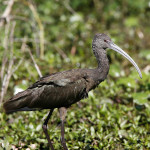White-faced Ibises have beautiful iridescent plumage that shines bronze, red and green in bright sun. It is hard to distinguish from its cousin, the Glossy Ibis, but it is by far the more common on the Texas coast. Most of the differences are subtle. The Glossy Ibis is smaller, and it’s plumage tends to be darker.

• Length: 23 inches
• Wingspan: 36 inches
• Season: Year-round
More about White-faced Ibises.
Where they are, and when.
Their habits are comparable to other wading birds, often probing the muddy waters of freshwater marshes with White Ibises at their side, searching for crawfish, frogs, small fish, crabs and insects. They fly in small groups, often in a line as you see with migrating birds, beating their wings between short intervals of gliding.
White-faced Ibises gather in colonies, building nests in the spring among marsh grasses or in trees. They produce three or four greenish-blue eggs.
February 16, 2013
The White Ibises seemed to be paired up with White-faced Ibises throughout Brazos Bend State Park today. It’s odd how some minor coloration or feature on a bird works its way into its name. Only during breeding season does the White-faced Ibis sport a white face, and even then it’s just a subtle outline around its then reddish face. I suppose the problem is that its cousin, the Glossy Ibis, stole the name that best describes its dark, colorful plumage.





